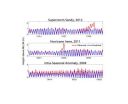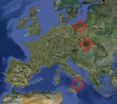(Press-News.org) The effects of storm surge and sea-level rise have become topics of everyday conversation in the days and weeks following Hurricane Sandy's catastrophic landfall along the mid-Atlantic coast.
Ongoing research by professor John Brubaker of the Virginia Institute of Marine Science is throwing light on another, less-familiar component of sea-level variability—the "intra-seasonal" changes that occupy the middle ground between rapid, storm-related surges in sea level and the long-term increase in sea level due to global climate change.
"These are cases when the water is just 'running high,'" says Brubaker, "but not from an obvious direct cause of a storm. It isn't necessarily windy, it's just an elevated water level without a clear cause."
Intra-seasonal variability—which Brubaker says takes place on time-scales of 10 to 90 days and can add or detract a foot or more from the predicted tide—is likely due to shifts in oceanic currents and large-scale movements of water masses along the coast. It often goes unacknowledged in discussions of sea-level trends, but can play an important role in water-level forecasts, coastal activities, and ecosystem health.
"Intra-seasonal variability has significant impacts," says Brubaker. "For instance, being aware of these non-tidal, non-storm anomalies is very important for forecasting. If you're experiencing a relative high during the approach of a storm, with water levels already elevated by a foot or more above predicted tides, that could make a big difference in terms of storm surge and coastal flooding."
Brubaker, who teams with researchers John Boon and David Forrest on the Tidewatch Forecast system at VIMS, says the Tidewatch forecasts account for at least some part of intra-seasonal variability by using as their starting point a moving average of the most recent 30 days of sea-level measurements. Other forecasts use mean sea level, a tidal datum that NOAA defines as the average measured over the years 1983-2001.
Brubaker notes that intra-seasonal variability can also impact marine life, most notably underwater grasses. Dr. JJ Orth, head of the Seagrass Monitoring and Restoration Program at VIMS, raised concern during a period of unusually high water in May 2011, noting that "with water levels this high above predicted, it means less light for seagrasses, and with light declining exponentially with depth it could mean added stress to plants at the deeper edges of the grass beds."
Periods of unusually low water could also affect seagrasses and other marine life, says Brubaker, but the impacts are likely to be less significant because the long-term rise in sea level tempers their effects.
The Summer 2009 Event
Brubaker's interest in intra-seasonal variability was piqued during summer 2009—when a prolonged period of high water affected the U.S. East Coast—and again during the shorter period of unusually high water during May 2011, which he experienced first-hand while teaching a course at VIMS' Eastern Shore Lab in the seaside village of Wachapreague.
"The 2009 event got a lot of attention—eventually," says Brubaker. "It wasn't dramatic and it took quite a while to gain much attention, but at some point NOAA posted a notice about it in response to questions and concerns from the public, who had noticed week after week of abnormally high tides."
Three NOAA scientists, Bill Sweet, Chris Zervas, and Stephen Gill, subsequently issued a technical report to describe and explain the 2009 event. They note that water levels of 0.6 to 2.0 feet above predicted tides persisted for up to 6 weeks in areas from North Carolina to New Jersey, with slightly lower elevations experienced as far south as Florida and as far north as Maine.
If intra-seasonal changes in sea level aren't generated by regular tides, storm surge, seasonal heating or cooling, or long-term sea-level rise, what is their cause? Sweet, Zervas, and Gill attributed the 2009 event to the confluence of two factors—persistent winds from the northeast measured far offshore, and a slow-down in the Gulf Stream.
Brubaker says the northeasterly winds contributed to high water along the coast due to "Ekman transport," a phenomenon in which surface waters begin to move to the right of the prevailing wind because of the Coriolis force. "The Ekman transport associated with these winds would push the water towards the shore," says Brubaker. Persistent offshore winds from the northeast were also measured during May 2011.
The slow-down in the Gulf Stream contributed to 2009's persistently high water levels through the re-positioning of what oceanographers call a "geostrophic slope." "The Gulf Stream creates a geostrophic slope that's related to the speed of the current," says Brubaker. "If the current speeds up, the slope gets steeper, and if the current slows down, the slope levels off. We on the East Coast are on the low side of the geostrophic slope, so as the Gulf Stream slowed down during the summer of 2009, the slope flattened out and water levels rose."
Preliminary Results
Brubaker's interest in intra-seasonal variability focuses on using tidal records from the last 15 years along the U.S. East Coast to better understand the frequency, magnitude, and duration of high-water events in the region. He's also interested in how these events propagate spatially through coastal water bodies like Chesapeake Bay.
"Our results are very preliminary at this point," says Brubaker, "but there are a few things that stand out. One is that July and August are typically relatively quiet in terms of intra-seasonal high-water events. Another is that there is a lot of year-to-year variability. There seem to be more active years in terms of these events and then multi-year periods of relative quiet."
He says the data also suggest an intriguing correlation between the high-water events and the occurrence of El Niño in the Pacific, as measured by the "Oceanic Niño Index," a commonly used measure of El Niño-La Niña activity.
"You can't help but notice," he says, "that the spikes in the duration of high-water events seem to correspond to the very strong El Niño event in 1997-98, and again in 2009-10, which is the next biggest El Niño peak. There's obviously not a direct correlation through the years, but El Niño is known for its teleconnections and effects that happen at great distances. So it's not unreasonable to think that there might be some connection there. It's something we continue to keep track of."
Intra-seasonal Variability in Chesapeake Bay
Brubaker's study of how high-water pulses propagate through Chesapeake Bay has also produced some interesting preliminary results. "The magnitude of the peaks in non-tidal water level are pretty consistent across the lower, middle, and upper parts of the Bay," says Brubaker. "But their impacts can be quite different because of the different tidal ranges in those areas."
Brubaker notes that tides in Chesapeake Bay are driven by the ebb and flow of water at its mouth. "The tidal range is higher at the mouth of the Bay, drops to lower levels in the mid-Bay, and then picks up again in the upper Bay," says Brubaker. "Because of that, a coherent peak in water level during an intra-seasonal event will have the greatest impacts in the mid-Bay, where the tidal range is lowest."
Explaining further, Brubaker introduces the term "highest astronomical tide," or HAT, which is the highest high tide predicted for any particular tidal station. "Near the Bay mouth, at the Chesapeake Bay Bridge Tunnel, the HAT is 2.5 feet above mean sea level," says Brubaker, "but at Solomons Island in the mid-Bay, it's only 1.1 feet—so there's a big difference. In 2009, water levels were elevated at all the tidal stations in Chesapeake Bay for about 6 weeks from June into July, but at the Bridge Tunnel they only exceeded HAT for 24 hours, a cumulative total of 2 days. At Solomons, by contrast, the water level exceeded HAT during almost every high tide. In fact, there was a period when the whole tidal cycle, from high through low tide, remained above HAT. All told, water levels at Solomons exceeded the HAT for a total of 15 days from June into July.
"The bottom line," says Brubaker, "is that the same rise in water level will have different impacts at different locations in the Bay. Even though the water rises uniformly, the relative impact will differ by location and the level of the highest astronomic tide. HAT is an important datum for ecosystems, and it should be an important datum for people too. City planners, waterfront property owners, and land-use decision makers shouldn't build too close to the HAT where they live. When they do, they're likely to get in trouble."
INFORMATION:
Researcher studies 'middle ground' of sea-level change
'Intra-seasonal' variability impacts forecasting and ecosystems
2012-11-27
ELSE PRESS RELEASES FROM THIS DATE:
From Mediterranean coasts to Tatra Mountains and beyond: Plant chromosome number variation
2012-11-27
Chromosome number is the most basic feature concerning the genome of a species, and it is known for about one third of higher plant species. In particular, for plants of Italy, Slovakia, and Poland, online chromosome number databases have been developed: 'Chrobase.it – Chromosome numbers for the Italian flora', 'Karyological database of ferns and flowering plants of Slovakia' and 'Chromosome number database – PLANTS', respectively. The three datasets account for about 35%, 60% and 40% of the whole floras, respectively.
"We used these datasets to compare chromosome number ...
Researchers explore social media as preventative method for infectious diseases
2012-11-27
MANHATTAN, Kan. -- When it comes to stopping illness, social media posts and tweets may be just what the doctor ordered.
A Kansas State University-led research team is looking at social media as a tool to reduce and prevent diseases from spreading. Researchers are studying whether a well-timed post from a public authority or trustworthy person could be as beneficial as flu shots, hand-washing or sneezing into an elbow.
"Infectious diseases are a serious problem and historically have been a major cause of death," said Faryad Sahneh, Kansas State University doctoral candidate ...
Man's best friend: Common canine virus may lead to new vaccines for deadly human diseases
2012-11-27
Athens, Ga. – Researchers at the University of Georgia have discovered that a virus commonly found in dogs may serve as the foundation for the next great breakthrough in human vaccine development.
Although harmless in humans, parainfluenza virus 5, or PIV5, is thought to contribute to upper respiratory infections in dogs, and it is a common target for canine vaccines designed to prevent kennel cough. In a paper published recently in PLOS ONE, researchers describe how this virus could be used in humans to protect against diseases that have eluded vaccine efforts for decades.
"We ...
Galapagos tortoises are a migrating species
2012-11-27
This press release is available in German.
The Galapagos giant tortoise, one of the most fascinating species of the Galapagos archipelago, treks slowly and untiringly across the volcanic slopes. Scientists of the Max Planck Institute for Ornithology in Radolfzell, together with the Charles Darwin Foundation, have used GPS technology and modern 3D acceleration measurements to find out that especially the dominant male tortoise wanders up to 10 kilometres into the highlands of the island. Only the fully grown animals migrate, the young tortoises stay year round in ...
Do missing Jupiters mean massive comet belts?
2012-11-27
Using ESA's Herschel space observatory, astronomers have discovered vast comet belts surrounding two nearby planetary systems known to host only Earth-to-Neptune-mass worlds. The comet reservoirs could have delivered life-giving oceans to the innermost planets.
In a previous Herschel study, scientists found that the dusty belt surrounding nearby star Fomalhaut must be maintained by collisions between comets.
In the new Herschel study, two more nearby planetary systems – GJ 581 and 61 Vir – have been found to host vast amounts of cometary debris.
Herschel detected ...
Researchers study cry acoustics to determine risk for autism
2012-11-27
Autism is a poorly understood family of related conditions. People with autism generally lack normal social interaction skills and engage in a variety of unusual and often characteristic behaviors, such as repetitive movements. While there is no specific medical treatment for autism, some success has been shown with early behavioral intervention.
Understanding the importance of early diagnosis, researchers at Women & Infants' Brown Center for the Study of Children at Risk in collaboration with researchers at University of Pittsburgh have been studying the cry acoustics ...
Flu outbreaks predicted with weather forecast techniques
2012-11-27
Contact: David Hosansky
hosansky@ucar.edu
303-497-8611
Zhenya Gallon
zhenya@ucar.edu
303-497-8607
National Center for Atmospheric Research/University Corporation for Atmospheric Research
Flu outbreaks predicted with weather forecast techniques
BOULDER – Scientists at Columbia University and the National Center for Atmospheric Research have adapted techniques used in modern weather prediction to generate local forecasts of seasonal influenza outbreaks. By predicting the timing and severity of the outbreaks, this system can eventually help health officials ...
Cell Transplantation reports islet cell advancement increases impact on transplantation
2012-11-27
Putnam Valley, NY. (Nov. 27, 2012) – A study published in the current issue of Cell Transplantation (21:8), now freely available on-line at http://www.ingentaconnect.com/content/cog/ct/ , reports that a team of researchers in South Korea have successfully engineered islet cell clusters (ICCs) that will improve pancreatic islet transplantation and offer promise for curing diabetes mellitus.
Carried out by collaborating researchers at three universities in Seoul, Korea, the new process of creating ICCs included delivering a gene to single islet cells that increased their ...
An energy conscious workforce: New research looks at how to encourage staff to go green
2012-11-27
As homeowners we are becoming cannier about turning down the thermostat to save our pennies and the planet but are we as energy conscious when we get to work?
A new £1.3m project, being led by researchers at The University of Nottingham, is to look at people's attitudes to energy consumption in the workplace and how to encourage colleagues to work together in reducing their organisation's carbon footprint.
Drawing on technical expertise at Nottingham's Horizon Digital Economy Research and design skills of experts at The University of Southampton, the five-year study ...
Study suggests different organ-derived stem cell injections improve heart function
2012-11-27
Putnam Valley, NY. (Nov. 27, 2012) – A study published in the current issue of Cell Transplantation (21:8), now freely available on-line at http://www.ingentaconnect.com/content/cog/ct/, has found that when mesenchymal cells derived from skeletal muscle (SM-MSCs) or adipose tissue (ADSCs) were injected into the heart muscle (myocardium) of separate groups of laboratory rats that had suffered a myocardial infarction, rats in both groups experienced significantly improved left ventricle function and smaller infarct size after cell therapy.
The study, carried out by researchers ...
LAST 30 PRESS RELEASES:
Experiments advance potential of protein that makes hydrogen sulfide as a therapeutic target for Alzheimer’s disease
Examining private equity’s role in fertility care
Current Molecular Pharmacology achieves a landmark: real-time CiteScore advances to 7.2
Skeletal muscle epigenetic clocks developed using postmortem tissue from an Asian population
Estimating unemployment rates with social media data
Climate policies can backfire by eroding “green” values, study finds
Too much screen time too soon? A*STAR study links infant screen exposure to brain changes and teen anxiety
Global psychiatry mourns Professor Dan Stein, visionary who transformed mental health science across Africa and beyond
KIST develops eco-friendly palladium recovery technology to safeguard resource security
Statins significantly reduce mortality risk for adults with diabetes, regardless of cardiovascular risk
Brain immune cells may drive more damage in females than males with Alzheimer’s
Evidence-based recommendations empower clinicians to manage epilepsy in pregnancy
Fungus turns bark beetles’ defenses against them
There are new antivirals being tested for herpesviruses. Scientists now know how they work
CDI scientist, colleagues author review of global burden of fungus Candida auris
How does stroke influence speech comprehension?
B cells transiently unlock their plasticity, risking lymphoma development
Advanced AI dodel predicts spoken language outcomes in deaf children after cochlear implants
Multimodal imaging-based cerebral blood flow prediction model development in simulated microgravity
Accelerated streaming subgraph matching framework is faster, more robust, and scalable
Gestational diabetes rose every year in the US since 2016
OHSU researchers find breast cancer drug boosts leukemia treatment
Fear and medical misinformation regarding risk of progression or recurrence among patients with breast cancer
Glucagonlike peptide-1 receptor agonists and asthma risk in adolescents with obesity
Reviving dormant immunity: Millimeter waves reprogram the immunosuppressive microenvironment to potentiate immunotherapy without obvious side effects
Safety decision-making for autonomous vehicles integrating passenger physiological states by fNIRS
Fires could emit more air pollution than previously estimated
A new way to map how cells choose their fate
Numbers in our sights affect how we perceive space
SIMJ announces global collaborative book project in commemoration of its 75th anniversary
[Press-News.org] Researcher studies 'middle ground' of sea-level change'Intra-seasonal' variability impacts forecasting and ecosystems




